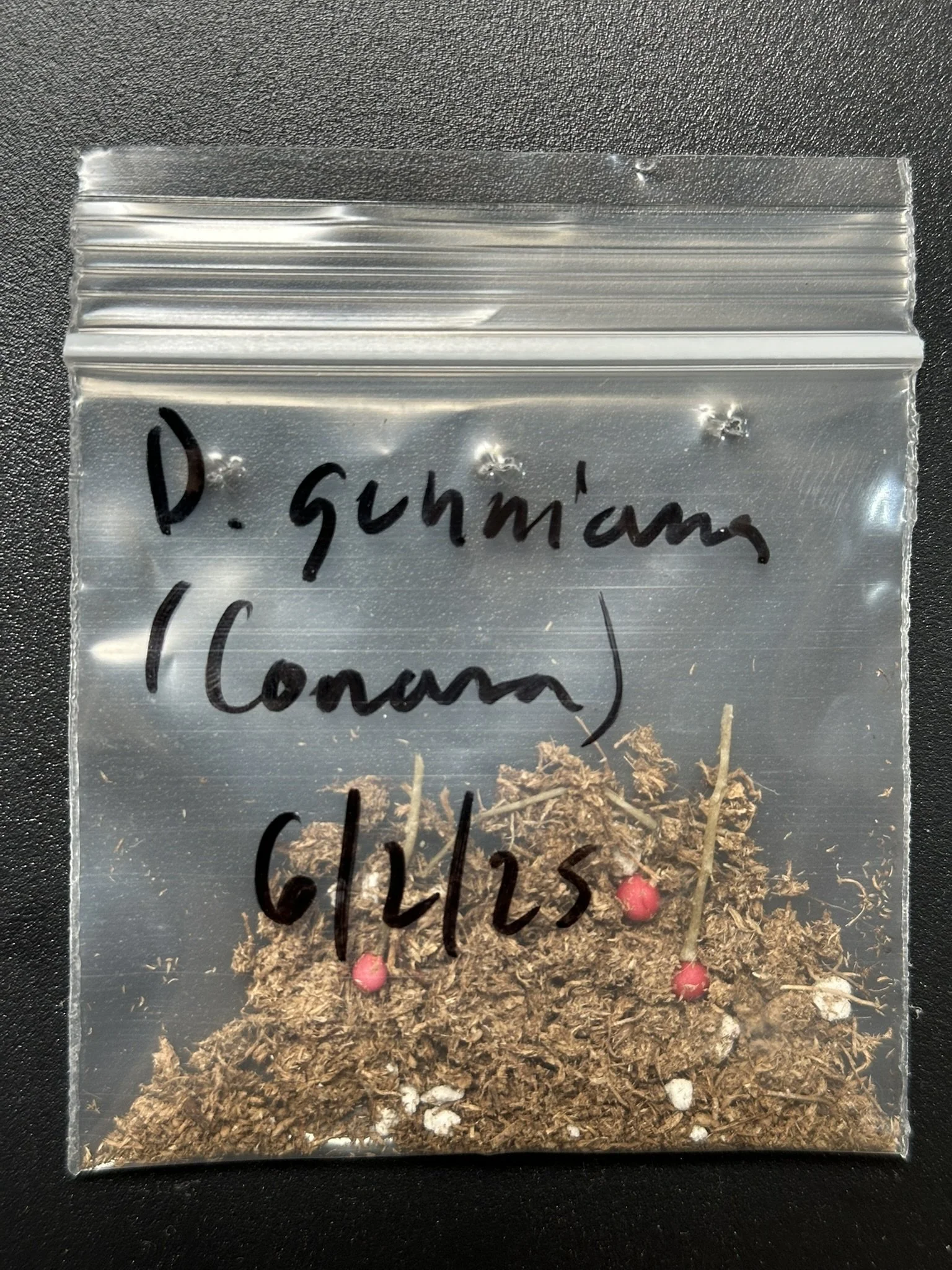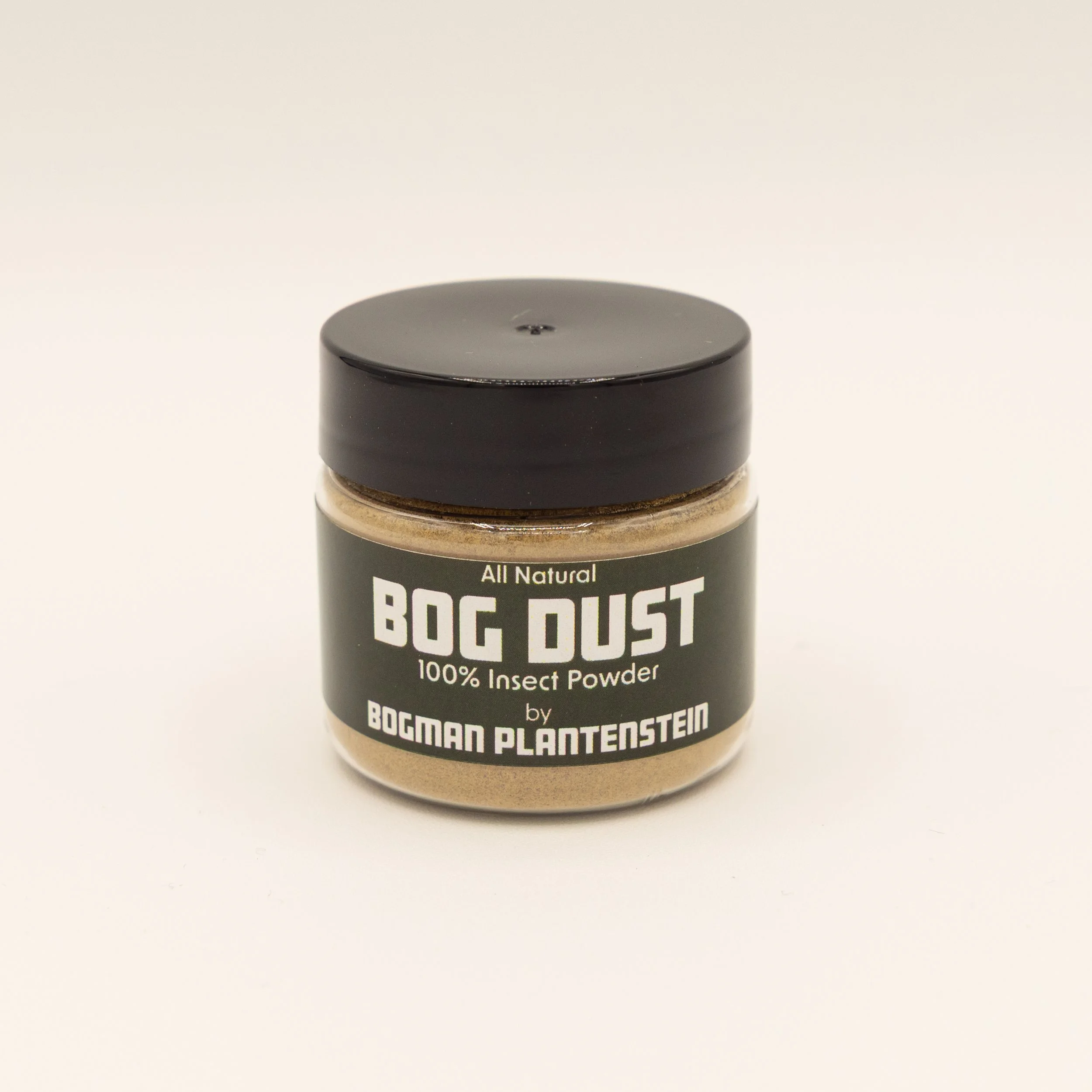 Image 1 of 2
Image 1 of 2

 Image 2 of 2
Image 2 of 2



TUBERS - Drosera gunniana (Conara, Tasmania, Australia)
Description
Drosera gunniana is stem-forming tuberous sundew that begins with a rosette, then sends up a stem with shield-shaped leaves. The stems can grow to over 1’ tall and dark red in color under bright light. The small whitish flowers readily self-pollinate and produce lots of linear seeds. It can be easily distinguished from Drosera auriculata by the hairy sepals and oblong seed (compared to glabrous sepals and linear seed). This form comes from Conara in Tasmania, Australia.
Tuberous sundews come from Western Australia and grow during the cool and wet winters, dying back to underground tubers in the hot and dry summers. In around October-November, the tuber will send up a thin stem that emerges at the surface with a bud of new leaves, creating a fresh rosette in about a week. This plant needs to feed and store energy in its tuber and the leaves/stem will turn brown and die when the rain stops and the soil dries out by around May.
While they are the most beautiful of all the Sundews, tuberous sundews are also the most challenging to grow. Their seasonal requirements are strictly necessary and understanding proper moisture through the dormancy period is critical. Unlike most bog plants, these prefer better drainage and slightly drier soils.
This form of Drosera gunniana is maybe the easiest tuberous sundew for those new to tubers and is quite forgiving for dormancy. I have kept it continually wet and it continues to grow (although not ideal). It readily germinates without treatment and grows very fast within its first season reaching flowering size on several inch tall stems.
The tubers appear small (~1/8” diameter) and red but will sprout into full sized plants in late fall. Tuberous Sundews need to stay dry during their summer dormancy to avoid rotting. A tiny amount of residual moisture is necessary to keep the tubers alive during dormancy. During summer, tubers can be allowed to slowly dry out in their pots, then occasional spritzing with water to prevent desiccation (this will depend on your exact conditions).
Upon arrival, tubers can be stored in a cool, dark place temporarily, but should be planted well before ~October since they can produce a vertical stem in late summer in anticipation of the rains of fall/winter. Soil should be kept mostly dry until around October when small amounts of moisture can be introduced to facilitate emergence from dormancy.
Each order will contain 1 medium sized tuber that will grow into a mature, flowering sized plant.
Growing Information
Climate: Mediterranean (SW Australia). 40-85F, low to moderate humidity. High temperatures can cause the plants to prematurely go dormant.
Light: Full to Part Sun or 15W per sq ft LED light. Tuberous sundews love bright light but do not require as much as other sundews.
Water: Distilled or Reverse Osmosis water. Sitting in 0.5” of water using tray method.
Soil: 40% Peat: 60% Perlite/Sand is a good mix. Tuberous Sundews like well draining soils and less moisture than bog plants. Rinse media with distilled or reverse osmosis water to remove excess salts.
Feeding: Feed leaves with Insect Powder every couple weeks or so. Tuberous Sundews need to feed regularly during the short winter growing season to gain size and to produce a healthy tuber at the end of the season.
Description
Drosera gunniana is stem-forming tuberous sundew that begins with a rosette, then sends up a stem with shield-shaped leaves. The stems can grow to over 1’ tall and dark red in color under bright light. The small whitish flowers readily self-pollinate and produce lots of linear seeds. It can be easily distinguished from Drosera auriculata by the hairy sepals and oblong seed (compared to glabrous sepals and linear seed). This form comes from Conara in Tasmania, Australia.
Tuberous sundews come from Western Australia and grow during the cool and wet winters, dying back to underground tubers in the hot and dry summers. In around October-November, the tuber will send up a thin stem that emerges at the surface with a bud of new leaves, creating a fresh rosette in about a week. This plant needs to feed and store energy in its tuber and the leaves/stem will turn brown and die when the rain stops and the soil dries out by around May.
While they are the most beautiful of all the Sundews, tuberous sundews are also the most challenging to grow. Their seasonal requirements are strictly necessary and understanding proper moisture through the dormancy period is critical. Unlike most bog plants, these prefer better drainage and slightly drier soils.
This form of Drosera gunniana is maybe the easiest tuberous sundew for those new to tubers and is quite forgiving for dormancy. I have kept it continually wet and it continues to grow (although not ideal). It readily germinates without treatment and grows very fast within its first season reaching flowering size on several inch tall stems.
The tubers appear small (~1/8” diameter) and red but will sprout into full sized plants in late fall. Tuberous Sundews need to stay dry during their summer dormancy to avoid rotting. A tiny amount of residual moisture is necessary to keep the tubers alive during dormancy. During summer, tubers can be allowed to slowly dry out in their pots, then occasional spritzing with water to prevent desiccation (this will depend on your exact conditions).
Upon arrival, tubers can be stored in a cool, dark place temporarily, but should be planted well before ~October since they can produce a vertical stem in late summer in anticipation of the rains of fall/winter. Soil should be kept mostly dry until around October when small amounts of moisture can be introduced to facilitate emergence from dormancy.
Each order will contain 1 medium sized tuber that will grow into a mature, flowering sized plant.
Growing Information
Climate: Mediterranean (SW Australia). 40-85F, low to moderate humidity. High temperatures can cause the plants to prematurely go dormant.
Light: Full to Part Sun or 15W per sq ft LED light. Tuberous sundews love bright light but do not require as much as other sundews.
Water: Distilled or Reverse Osmosis water. Sitting in 0.5” of water using tray method.
Soil: 40% Peat: 60% Perlite/Sand is a good mix. Tuberous Sundews like well draining soils and less moisture than bog plants. Rinse media with distilled or reverse osmosis water to remove excess salts.
Feeding: Feed leaves with Insect Powder every couple weeks or so. Tuberous Sundews need to feed regularly during the short winter growing season to gain size and to produce a healthy tuber at the end of the season.


